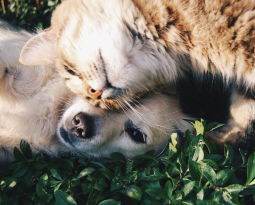Did you know aggression is one of the most common behavioral problems amongst cats? While many know cats to be affectionate and soft creatures, cats are also capable of experiencing distress. An aggressive or angry cat can be quite dangerous as their teeth and sharp claws can cause injuries to people, especially children, and other pets.
So if your furry friend has been displaying signs of anger lately, there are some ways to help. Let’s look at how to calm an angry cat.
Signs of an Angry Cat
It is important to recognize what an angry cat may look like or what kind of behaviors they may display. Here’s what you can expect from them:
- Growling
- Avoiding their favorite toy
- Hiding and refusing to come out
- Ears are flattened back and sticking out
- Biting when you try to pet them
- Twitching tail
- Refusing favorite meal
- Purring*
- Clawing at furniture
*Purring can mean so many things. It is a cat’s primary way of communicating with other animals and humans and can both be a sign of distress and happiness.
Before you attempt to calm an angry cat, the next best step would be to try and find the source of its aggression. Some reasons they may be angry include fear, pain, conflict with another cat, or territorial aggression.
Once you pinpoint where the aggressive behavior is coming from, you can then try to help your cat. Here are 3 ways to help calm an angry cat.
Act Small and Approach Slowly
A cat might display angry behavior out of fear. They might feel as if something or someone is a threat to their environment. You can help ease this fear by showing them you are not a threat. Never make a cat feel like it is cornered. A cornered cat is likely to lash out, even if it has never done so in the past. Be sure you approach them slowly and safely, and leave them an escape plan.
One way to do this is to lie on the floor or sit on the couch while remaining at a distance. This shows them that you’re not a threat and have no intention of touching them or bothering them. It lets them get used to your presence naturally. This can take time and many attempts, especially if the cat doesn’t know you.
Once it seems like your cat’s aggressive behavior has calmed down, you can try to approach your cat. Remember to do this cautiously and slowly. You can also hold a treat and let your cat come to you. If the cat runs, don’t try to chase it. Cats are creatures of habit and will likely return to that spot once they feel safe.
If they do approach you, they might sniff around you or jump. Try to stay very still and make slow movements to help keep them comfortable.
Interrupt the Behavior
Ignoring your cat’s behavior or backing off can sometimes be a wise choice. Doing this can ease tension and let your cat know there is nothing to worry about. In other instances, though, anger or aggression in a cat can be dangerous and is better left not ignored.
You can try to interrupt your cat’s aggressive behavior by distracting them. You can shake a jar of coins, throw a small toy in their direction or lightly squirt them with a small water gun. Try to avoid shaking their food or treat pouch, as this is a reward and your cat will think acting mean will get them more treats in the future.
Do not punish, pick up or try to touch an angry cat as this might cause the cat to attack you. Instead, safely try to distract them from a distance in order to help them move out of their angry behavior.
Provide a Safe Environment
Providing a safe place for a cat to release their aggression can help calm an angry cat. A scratching post can act as a great alternative to your furniture and cat towers or condos are perfect places for your cat to hide, sleep or have some privacy.
If your cat is angry, he or she might also want to hide more than usual. Make sure that your cat’s kennel, bed or condo is in a quiet room and undisturbed area. This will allow your angry cat to have some space until they are ready to come out again.
Still Wondering How to Calm an Angry Cat?
If you have tried these methods but nothing’s helped, it might be time to contact your vet. They can give your cat a full health examination to check for any underlying illnesses or medical conditions. Some possible illnesses, where aggression is a symptom, are high fevers, ear problems, wounds or gingivitis.
If your vet out rules an illness, anger in cats could also be related to anxiety. Your cat might be experiencing anxiety towards a specific situation. In this case, anti-anxiety medication may be prescribed for your cat.
If you are in the Tucson area, give us a call! We, at Acoma Animal Clinic in Tucson, will work with you to find the underlying reason for your cat’s aggressive behavior and help bring back ease and peace to your companion.







